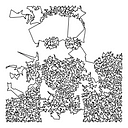A polymath melting pot
Crypto art is a fortunate encounter between art, technology, economics, and politics. It inherits from conceptual art, blockchain, cryptocurrencies, and the cypherpunk movement.
- The novel idea of crypto art is to associate a digital artwork with a non-fungible token or NFT;
- NFTs are cryptographic tokens stored on a blockchain that represent a unique digital asset;
- NFTs are not interchangeable and cannot be divided, as opposed to fungible tokens associated with cryptocurrencies;
- an NFT certifies the ownership (current owner) and provenance (historical owners and creator) of a digital artwork;
- an artwork can be minted by creating a transaction on the blockchain that generates the NFT and transfers it to the digital wallet of the artist. The mint transaction contains a link to the artwork’s metadata and a link to the artwork’s file that are both stored on IPFS;
- an artwork can be sold by making another transaction on the blockchain that transfers the NFT to the wallet of the collector and moves the agreed amount of cryptocurrency to the wallet of the artist.
The emotional spectrum of crypto art
In this work, we focus on the textual metadata that accompanies each artwork. This metadata is written by the artist and includes a title, a description and a list of tags for each artwork. The goal is twofold:
- discover what emotions (anger, fear, anticipation, trust, surprise, sadness, joy, or disgust) and sentiment poles (positive and negative) are expressed by crypto artists when they create digital art;
- find out if crypto collectors are influenced by these emotions when buying digital art.
The research methodology is as follows:
- we used over 25k artworks minted in SuperRare gallery, among the most important crypto art marketplaces by popularity and volume of exchanged artworks;
- we applied lexicon-based sentiment analysis using the NRC Emotion Lexicon by Saif Mohammad and Peter Turney and tidytext R package;
- for each artwork and emotion, we computed an emotional score of the artwork as the relative number of words used in the artwork metadata that match the emotion.
As a curiosity, the artwork leading the ranking for emotions fear and anger is Inferno III: Lake of Fire by deathimself. This is an excerpt from the author’s description:
The heat is intense, your flesh feels as if it’s been melted off entirely, and the smell of sulfur and burning meat fills the air.
On the other hand, joy and surprise both emerge in Spring Bloom by kristyglas. The artwork’s description starts as follows:
Air was fresh and sweet and luminous petals flowed in the warm breeze. Plants and trees bloomed in magnificent colors, so much beauty to take in.
We are first interested to explore the following queries:
- what are the emotions and sentiment poles that are most expressed by crypto artists?
- What is the temporal evolution of the emotional spectrum?
Emotions joy, trust and anticipation lead the emotional spectrum. They are followed, at a distance, by fear and sadness, while disgust is the least represented emotion. Positive sentiments neatly dominate negative ones all over the history of the gallery.
We now want to find out if the same holds for collectors:
Do they collect artworks that express clear emotions?
To find an answer we correlated the emotional scores of artworks with several indicators of market success, including bids and sales on both primary and secondary market. We noticed no correlation, either positive or negative, among sentiment and market success of the artworks. We conclude that:
While the average artist favors some emotions among others, in particular the positive ones, the average collector is totally agnostic to the emotion expressed by the art they collect.
The present work is a preliminary study and it is part of a larger system of art recommendation and discovery we are currently building within a startup devoted to blockchain art market analytics. It has some known limitations that we want to acknowledge in the following:
- we are assuming that the feelings of the artist are expressed by their work and in particular that they are expressed by the texts that describe it;
- we did not consider the visual qualities of the artwork and we assume that there is no major discrepancy between emotions expressed in the artwork and those conveyed in its metadata;
- we did not compare the outcomes in other art-related corpora.
